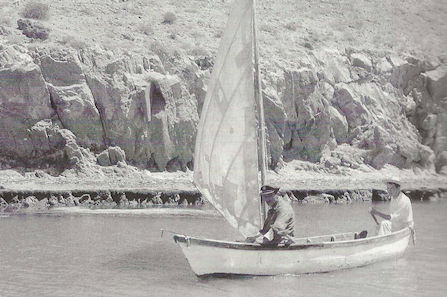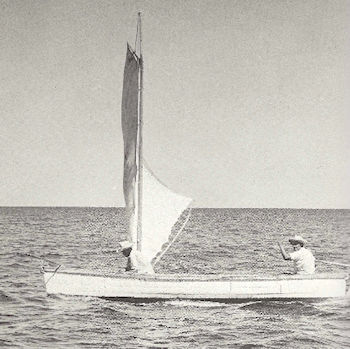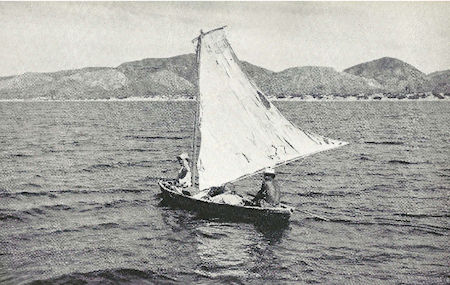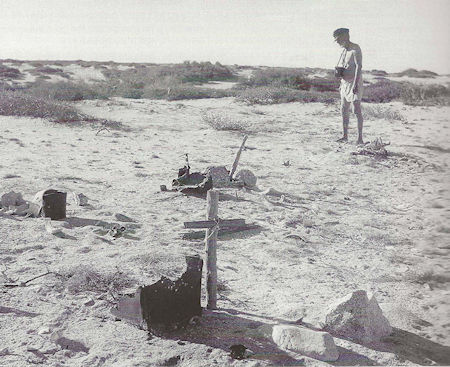 |  |
By Greg Niemann

Among the most unique and endearing images from the Sea of Cortez are those of the “vagabundos del mar” or sea gypsies. During the mid-20th century these wandering fishermen, usually two to a boat, ceaselessly plied the Sea of Cortez in small crafts. They would then stay a night or two in thatched lean-tos built in coves on islands and remote Baja beaches.
Their boats were seldom longer than 16 feet, mostly 48” wide, and 25” deep, and more often than not were simply constructed, as they had been for decades. While some used dinghies of planking, favored was the boat of a single hollow log built by Indians on mainland ports where large trees were more available.
The tall mast, carved from a single straight tree, was the most noticeable feature, with makeshift patchwork sails to take advantage of winds. Paddle steering and oar-power was supplemental and regularly applied by the wanderers.
Modern day nomads, these sea gypsies went out in all sorts of conditions, from blistering heat to chubasco-driven winds. Their knowledge gleaned from years at sea replaced charts and compasses and other devices of modern mariners.
Famed California author John Steinbeck (in The Sea of Cortez, 1941) reported about a 1940 encounter with a couple of vagabundos: “They were barefoot and carried the iron harpoons of the region, and in the bottom of their canoe lay a huge fish. Their canoe was typical of the region and was quite interesting.

“There are no large trees in the southern part of the Peninsula, hence all the canoes come from the mainland, most of them being made near Mazatlan. They are double-ended canoes carved from a single log of light wood, braced inside with struts. Sometimes a small sail is set, but ordinarily they are paddled swiftly by two men, one at either end. They are seaworthy and fast. The wood inside and out is covered with a thin layer of white or blue plaster, waterproof and very hard. This is made by the people themselves and applied regularly. It is not a paint, but a hard, shell-like plaster...”
These wanderers, who in the late 1950s numbered about 75 or 80 (to other estimates of between 100-300) fishermen in about 50 pangas or conaos, tended to keep the boats far apart from each other and only made brief visits to civilization.
It has been reported by many who have encountered them that while they might be friendly and helpful, they also preferred to keep to themselves and would not go out of their way to seek your company.
Author Spencer Murray was impressed with these primitive seafarers. In his 1963 book Cruising the Sea of Cortez he related, “Vagabundos del mar - sea wanderers - are a curious lot. They pursue their only trade with a vengeance, putting to sea in a craft without fear of Gulf storms or suddenly-formed whirlpools. They go out on blistering hot days and on freezing winter nights. All they own in the world they carry with them and they have no real home ashore.
“They carry no compass or chart, and wouldn’t know how to use either if they did. But they know the Gulf and its idiosyncrasies as one knows his own backyard.”
Murray, who cruised in his boat Peggy Sue over 1400 miles within the Gulf, noted encountering many of the vagabundos. “We ran across many of them along our route, even meeting them as far at sea it would have taken a good wind two days to blow them ashore.

“And we met them in the evenings when we unknowingly invaded ‘their’ beaches in search of an anchorage for the night. We often saw them fishing in little harbors and coves during the day. But at times they were incommunicative and withdrawn and we soon learned simply to ignore them just as they ignored us.”
Murray added, “The vagabundo, as its title implies, wanders ceaselessly; staying one night on this island, the next on another. They stay in lean-tos built of cactus limbs or driftwood, the nearest things to houses that the vagabundos have.
“The lean-tos are what we might call community shelters for they belong to the vagabundos as a group.”
The vagabundos’ touch with civilization was extremely limited. Every now and then, as additional supplies were needed, they would take turtles, fish, dried and salted shark meat and livers to the nearest port village or town to trade for staples.
Usually their only possessions, according to popular Baja author/writer Ray Cannon, (in Sea of Cortez, 1966) “were confined to heavy hand lines and hooks for fishing, a harpoon for spearing sharks, turtles and larger fish, a couple of pots for cooking, a machete, bottles of water, a blanket and a coil of rope.
Cannon noted several encounters with the sea gypsies and often was in awe of them. “There are places where you may move along the coast of the Baja Peninsula for a hundred miles without finding any other sign of human inhabitancy, then suddenly see a dugout canoe in full sail, bearing a couple of our heroes bound for a better cove or wherever the wind blows them.”

Cannon wrote that a friend of his from Los Angeles cruising the Midriff area once saw a couple of vagabundos hook, battle, and finally land a black marlin aboard their small canoa. Remarkably, the marlin was reckoned by all to be about 1,000 pounds!
Cannon reported that once during a storm some 12-foot waves were about to swamp his outboard near an entrance to a bay, and a couple of the vagabundos saved him and his partner. “How they got to us, took us aboard, and landed us ashore in that raging blow, I still don’t know.”
He once mentioned, “On three occasions my companions and I have been saved from possible shipwreck by vagabundos, and at no time would they accept rewards. Our offers of cigarettes or wine were received socially as gifts but never as payment. The more I see and hear of these happy wanderers, the more I envy them.”
For the most part, the vagabundos were Mexicans who were tired of working for others and abiding by all the rules and laws of land-based society. Many were enticed by the shark-liver boom of the 1950s. Imitating some of the Indians who lived in the north end of the Sea of Cortez, they took to the sea. Their complete freedom of movement and carefree existence inspired many, including Cannon, who called them the “true escapists.”
Cannon even admitted, “With strenuous effort, I have succeeded in evolving from a position of fame and wealth to the enviable status of vagabundo del mar (sea-going gypsy) and I wouldn’t trade jobs with any man on earth.”
In 1960, in his Western Outdoor News column, Cannon reported coming across a graveyard with a couple dozen crosses on the southern tip of Cerralvo Island. His guide from the Rancho Bueno Vista, Eusebio “Laborio” Cocio, a former seafaring gypsy himself, said it was a vagabundo graveyard. He said that the vagabundos stopped their roaming only when they died and tradition called for them to be buried on the southernmost tip of Cerralvo Island.

I had to make a claim. They made the process easy and friendly. Using email was also helpful with...

As we were headed to Baja I had time to contact a few Mexico insurance options. The first company I...

Easy and friendly site to buy insurance. Good experience.